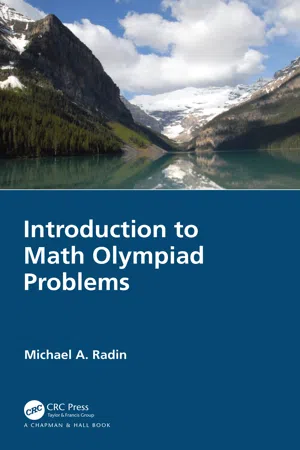
- 144 pages
- English
- ePUB (mobile friendly)
- Available on iOS & Android
eBook - ePub
Introduction to Math Olympiad Problems
About this book
Introduction to Math Olympiad Problems aims to introduce high school students to all the necessary topics that frequently emerge in international Math Olympiad competitions. In addition to introducing the topics, the book will also provide several repetitive-type guided problems to help develop vital techniques in solving problems correctly and efficiently. The techniques employed in the book will help prepare students for the topics they will typically face in an Olympiad-style event, but also for future college mathematics courses in Discrete Mathematics, Graph Theory, Differential Equations, Number Theory and Abstract Algebra.
Features:
- Numerous problems designed to embed good practice in readers, and build underlying reasoning, analysis and problem-solving skills
- Suitable for advanced high school students preparing for Math Olympiad competitions
Frequently asked questions
Yes, you can cancel anytime from the Subscription tab in your account settings on the Perlego website. Your subscription will stay active until the end of your current billing period. Learn how to cancel your subscription.
No, books cannot be downloaded as external files, such as PDFs, for use outside of Perlego. However, you can download books within the Perlego app for offline reading on mobile or tablet. Learn more here.
Perlego offers two plans: Essential and Complete
- Essential is ideal for learners and professionals who enjoy exploring a wide range of subjects. Access the Essential Library with 800,000+ trusted titles and best-sellers across business, personal growth, and the humanities. Includes unlimited reading time and Standard Read Aloud voice.
- Complete: Perfect for advanced learners and researchers needing full, unrestricted access. Unlock 1.4M+ books across hundreds of subjects, including academic and specialized titles. The Complete Plan also includes advanced features like Premium Read Aloud and Research Assistant.
We are an online textbook subscription service, where you can get access to an entire online library for less than the price of a single book per month. With over 1 million books across 1000+ topics, we’ve got you covered! Learn more here.
Look out for the read-aloud symbol on your next book to see if you can listen to it. The read-aloud tool reads text aloud for you, highlighting the text as it is being read. You can pause it, speed it up and slow it down. Learn more here.
Yes! You can use the Perlego app on both iOS or Android devices to read anytime, anywhere — even offline. Perfect for commutes or when you’re on the go.
Please note we cannot support devices running on iOS 13 and Android 7 or earlier. Learn more about using the app.
Please note we cannot support devices running on iOS 13 and Android 7 or earlier. Learn more about using the app.
Yes, you can access Introduction to Math Olympiad Problems by Michael A. Radin in PDF and/or ePUB format, as well as other popular books in Mathematics & Applied Mathematics. We have over one million books available in our catalogue for you to explore.
Information
CHAPTER 1
Introduction
The aim of this chapter is to get acquainted with the basic fundamental tools that we will use to approach, analyze and solve assorted problems that may require just one or two steps to solve or perhaps require multiple number of steps to solve. We will discover that every problem will reduce to understanding and deciphering of basic fundamentals. Therefore, it is vital to establish and understand the intrinsic knowledge that will guide us to unfolding very challenging problems. We will emerge with the foundation of assorted sequences and patterns.
1.1 Patterns and Sequences
This section’s aims are to recognize various patterns and sequences. We will commence with linear sequences where the difference between two neighboring terms is a constant. For instance, the sequence that lists the consecutive positive integers starting at 1 is graphically portrayed with the corresponding diagram.
Analytically, we express the sequence of positive integers in Figure 1.1 as
(1.1)

Figure 1.1 List of positive consecutive integers.
Analogous to Figure 1.1, we will assemble similar diagrams when solving related problems with consecutive integers and other homologous contents. In addition, (1.1) can be expressed as a recursive sequence. Observe that we start at 1 and tr...
Table of contents
- Cover
- Half Title
- Title Page
- Copyright Page
- Contents
- Preface
- Author Bio
- Acknowledgments
- Chapter 1 ▪ Introduction
- Chapter 2 ▪ Sequences and Summations
- Chapter 3 ▪ Proofs
- Chapter 4 ▪ Integers' Characteristics
- Chapter 5 ▪ Pascal's Triangle Identities
- Chapter 6 ▪ Geometry
- Chapter 7 ▪ Graph Theory
- Chapter 8 ▪ Answers to Chapter Exercises
- Chapter 9 ▪ Appendices
- Bibliography
- Index